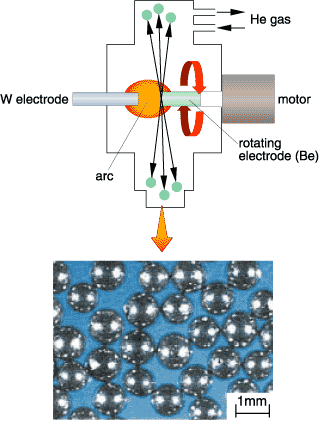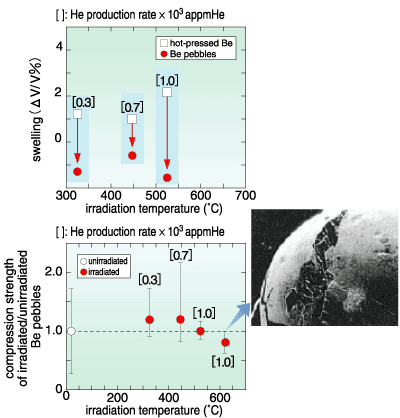A tritium breeding blanket will be installed in a fusion reactor to produce tritium as a fuel. In this blanket, beryllium will be used as a neutron multiplier to improve the efficiency of tritium breeding. Beryllium will be irradiated by a high fluence of neutrons (maximum fluence is equal to the production of one atom of helium per 50 atoms beryllium by the nuclear reactions) during the operation of a fusion reactor, and will be used at about 600°C maximum temperature. In this environment, the helium produced will lead to the swelling in the grain boundary of beryllium due to bubble formation and, in the worst case, the blanket will be fractured by the large swelling. To prevent the occurrence of this worst case, beryllium pebbles of 1 mm diameter are necessary because the small volume prevents the storage of helium. However, the fabrication of beryllium pebbles by conventional mechanical processes from hot-pressed beryllium needs a heavy effort. Therefore, the fabrication technology by the rotating electrode method was developed, and the fabrication of beryllium pebbles was successful.
In the rotating electrode method, a beryllium electrode rotates at high speed with a motor and beryllium is melted by the heat of the electric arc which is generated between the rotating beryllium electrode and a tungsten electrode. Then molten beryllium sprays with centrifugal force and forms pebbles (Fig. 2-21). The pebbles fabricated by this method were neutron-irradiated in JMTR, and the swelling and compression strength were examined. The results showed that pebbles had fewer swellings than hot-pressed beryllium (Fig. 2-22). The reason is considered to be that helium gas can be released more easily because the volume of pebbles is small and the helium gas that gathers on the grain boundary is reduced because the grain size (about 0.5 mm) is 50 times larger than that for hot-pressed beryllium. Also it was made clear that the compression strength is not changed by neutron irradiation. From these results, beryllium pebbles has been adopted as a neutron multiplier in the ITER design and the European demonstration reactor design on the SEAEP (Safety and Environmental Assessment of Fusion Power) project. Furthermore, beryllium pebbles were selected as a reference material, and an irradiation test is going to be started in Europe, USA, Russia, etc. |

